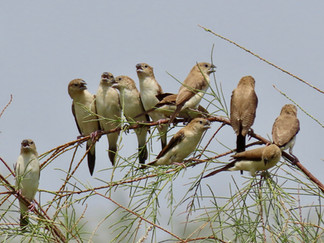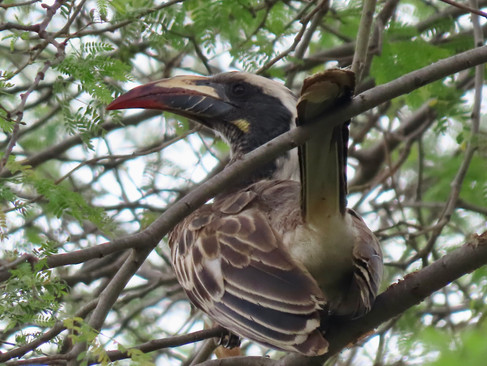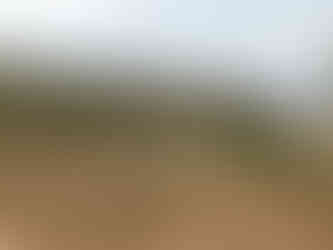Birding Jazan Province (Part One): The Tihama and the Mountains
- saudibirding
- May 22, 2021
- 10 min read
Updated: Aug 27, 2021
Highlights:
Lesser Flamingo
Bruce's Green-Pigeon
White-browed Coucal
Pied Cuckoo
Klaas's Cuckoo
African Palm-Swift
Abdim's Stork
Booted Eagle
Bonelli's Eagle
Dark Chanting-Goshawk
Shikra
African Gray Hornbill
White-throated Bee-eater
Abyssinian Roller
Arabian Woodpecker
Asir Magpie
Brown Woodland-Warbler
Arabian Wheatear
Arabian Golden Sparrow
Arabian Serin
Yemen Serin
Yemen Linnet
Cinnamon-breasted Bunting
My wife, Michelle, our friend Liz, and I arrived to Jizan the evening of May 11. The plan for the visit was six days of exploring around the province, starting with two full days in the mountains and wrapping up with two full days on the Farasan Islands. After sorting out our rental car with Yelo, we picked up water and snacks and then headed to our hotel, Al Borg Al Watheer, to rest up for our first full day of exploring.
May 12, 2021—Jizan to Jebel Al Aswad
I was up before dawn the next morning for a quick run by myself to Abu Arish. The goal of the morning was to perhaps catch a local flock of Arabian Golden Sparrows at their roost and record their vocalizations. When I arrived I discovered that the residents of the neighborhood were still up, celebrating the last day of Ramadan before the start of Eid Al Fitr. Young men were cruising around on motor bikes, and children were setting off fireworks from a nearby rooftop. Not ideal for recording bird vocalizations. Noisy flocks of House Sparrows were rousing in a few of the thicker trees, but I couldn't hear any golden sparrows among them.
When we had seen them in July 2020, the golden sparrows were resting in the lower half of an acacia tree in a local graveyard under the midday sun. I peered over the wall to the graveyard as we had done then, but none were roosting there as I had hoped. I explored a larger graveyard on the opposite side of the street, one with a thicker, shrubby patch against the back side, and found a mix of resident and migratory birds. The most interesting sighting here was a possible Blyth's Reed Warbler foraging in the lower shrubs--hopefully the images I managed to capture (below) will confirm the ID. African Collared-Doves called from deep within the trees and African Palm-Swifts passed just overhead. At one point I had a flyby Abdim's Stork. From this graveyard, I looked back over the wall towards the other and spotted two Arabian Golden Sparrows among a few Ruppell's Weavers, but I couldn't relocate them when I passed by a short time later.
On my way back to Jizan I drove through some farmland off the main road hoping to find more golden sparrows. No luck. This regional endemic has proven to be one of the trickiest and to date I haven't discovered a reliable spot to find them. I did find the first Pied Cuckoo of the trip perched on a power line alongside the road as well as a handful of White-throated Bee-eaters.
After picking up my wife and friend from the hotel, we made a brief stop at the Jazan Wastewater Treatment Plant to check out the flamingos. As with our last visit, Lesser Flamingo outnumbered Greater Flamingo by about four to one. This time we walked to the end of a dirt track leading out into the mangroves. In the trees to the right of us several Mangrove Reed Warblers could be heard singing; to the left of us, a smattering of shorebirds, White-winged Terns, and the first group of approximately 350 Lesser Flamingos. We could see remnants of nest mounds a short distance away but still no evidence that successful breeding has occurred at the site.
From there we hit the road for Al Sadd Lake, which some birders have called Lake Maliki. Where this name originates is beyond me. In Google Maps and on the signage around the lake, it is referred to as Al Sadd Lake (بحيرة السد) or Dam Lake—"sadd" meaning "dam" in Arabic. Just like our first visit to the lake in July 2020, it was quite hot and the humidity, while less than on the coast, still made for sweaty birding. The most interesting sightings here were four Abyssinian Roller at different spots to the east of the lake, four Pink-backed Pelicans on the lake proper along with White-winged and Whiskered Terns, Arabian Babbler, a couple White-browed Coucals, as well as some nice views of a Bruce's Green-Pigeon trying to escape the heat.
We continued on towards Jebel Al Aswad, stopping briefly in a wadi near Harub, where we saw a pair of African Gray Hornbill—the female wears the lipstick of course—and a Booted Eagle, only my second for Saudi.
Our accommodation for the next two evenings was the Jebel Al Aswad Hotel. This is where we stayed the last time; however, since then they had installed large picture windows in all of the rooms, allowing guests to enjoy the dizzying views from the narrow ridge line on which the village and hotel were built. Each time I go back I like it even more. Even Amer, the young man at reception, doubly impressed us this visit with his kindness and earnest efforts to speak Engli.
May 13, 2021—Jebel Al Qahar
The next morning we visited Jebel Al Qahar, a high-elevation plateau just north of Jebel Al Aswad that I only just recently confirmed the location of. I had read that this mountain had been a former stronghold of the Asir Magpie; however, the name of the mountain has been mistransliterated in English in nearly all of the literature on this endemic species as Jebel "Gaha". Searching Google Maps for "Gaha" and "Qaha" turned up nothing, but when I tried searching for these in Arabic the name "Jebel Al Qahar" (جبل القهر) appeared in the mountains of Jazan Province. This was the place, and I was surprised to discover that it was quite close to Jebel Al Aswad, which we had visited in July 2020. Part of the plan for this visit then was to ascend the mountain, the feasibility of which I wasn't entirely sure as much that I read or saw on YouTube (in Arabic) suggested that the road up was only paved about half way and the rest was a rugged dirt track, and see if we could find any. Birds of Saudi Arabia (2020) insists that the magpies' current range only extends from Al Namas to Billasmer, and made no mention of a possibly extant population on Jebel Al Qahar, and Jennings et al. only turned up two during their 2010 survey of the mountain, the last time as far as I know that any were reported from there. For the fact the population here appeared to have been written off as lost, I was excited at the prospect of successfully ascending the mountain and discovering magpies. Initially I considered hiring a guide with a 4x4 to take us up but then balked at the price (over $550 for the day) and figured we'd attempt it ourselves and deal with whatever came our way. The rental agency in Jizan provided us with an upgrade from the 4WD Santa Fe I had booked online to a Chevy Tahoe. Turns out only a short but somewhat rugged stretch of the road remains unpaved, but the Tahoe managed just fine. The early-morning drive up produced views of Arabian Partridge on the road.
Once we reached the top of the mountain, we were dismayed at the depressing state of the juniper stands that once covered the slopes running from the summit. By my estimate, around 90% of the trees were just skeletal remains. Birds you would expect from more open highland terrain were showing in good numbers—Tristram's Starling, Arabian Wheatear, and Long-billed Pipit were all quite abundant around the overlook. Fan-tailed Raven, Little Swift, Pale Crag-Martin and Red-rumped Swallow could be seen over head.
Shortly after reaching the summit, we stopped at a point facing east from the summit area and I heard, then saw, a Klaas's Cuckoo, which alighted on a nearby tree. Just as I was about take a picture, an Asir Magpie flew into the frame, scaring the cuckoo off, and perched at the center of my shot. Michelle and I both exclaimed simultaneously "magpie"! Now that we had found one, the mission changed to determining just how many were up there. The first bird flew to the south and led us to a wooded ravine on the eastern slope where a second bird and a few visible nests were observed. Further to the south we could hear others calling. I scanned the ridge in that direction and counted six more, two of which we observed more closely an hour or so later. Before descending the mountain we explored the northern section of the summit, which also bore the remains of once extensive stands of junipers, and found a lone magpie and the remains of several more nests. All in all we counted a total of 9 Asir Magpies, but I'm confident we would have turned up more had we stayed longer and covered more ground, such as the terrace farms on the northeast side of the mountain. This discovery shows just how incomplete the literature on the Asir Magpie actually is as much of it is based on a limited number of surveys and casual observations, which then, however, are written up as somehow conclusive rather than tentative. Given this population holds on at around 1900 meters in severely degraded habitat, I suspect that there are other areas in the southern highlands of the Asir region and Jazan Province where they are believed to have disappeared but may, in fact, still exist. The only way then to correct the record is to continue to get out and look for them.
Besides the cuckoo, Jebel Al Qahar held one more Saudi tick for me. While we were observing the magpie pair on the eastern side of the mountain, I noticed a largish gray form sitting upright on a dead branch further up the ravine from the magpies, which were calling noisily perhaps in response to its proximity to their nest. I could tell it was a raptor but the distance made it tough to determine which species. I zoomed in with my camera and once I saw the reddish-orange cere and legs I knew I had found my first Dark Chanting-Goshawk in the Kingdom. I took a few more pictures from a slightly better vantage, still somewhat distant, before the bird flew off further up the mountain.
Other interesting birds present on the mountain were Red-eyed Dove, Bruce's Green-Pigeon, Black and Yellow-billed Kite, Gray-headed Kingfisher, Arabian Woodpecker, Brown Woodland-Warbler, Abyssinian White-eye, Arabian Babbler, Little Rock Thrush, Palestine Sunbird, Arabian Waxbill, Yemen Serin, Yemen Linnet, Cinnamon-breasted Bunting along with a few late migrants. I could hear Arabian Serin singing in a few different spots but oddly we never laid eyes on any. Violet-backed Starlings were quite actively calling and courting. On two occasions we observed single stunning males flanked by a gaggle of females, each calling softly, seemingly vying for his attention. The male would fly off and the females would fly off after him. According to the species account in Cornell's Birds of the World, they are monogamous breeders, so I can only assume that this male hadn't yet paired up and these single females were competing for him as a mate.

Around 2 PM we began making our way back down the mountain. It was hard to shake the feeling of doom the state of the mountain's once-thick juniper forests provoked in me. I spoke briefly with one of the villagers, an older man perhaps in his early 70s, and he told me that the trees started dying off in the 1990s and claimed that it was a result of air pollution caused by Saddam Hussein's burning of the Kuwaiti oil fields during the First Gulf War, that when the rains came, toxins from the smoke leached into the soil and killed the trees. For sure, the burning of the oil fields as well as the oil spills that occurred in the Arabian Gulf were one of the worst environmental disasters of the 20th century; however, the fact that no other highland forests in the region appear to have suffered the same degree of die-off undercuts this theory. A significant El Niño event also occurred in the 1990s, resulting in an extended spell of hotter and drier weather in the southwest of the country; this event, perhaps in conjunction with or compounded by the broader, ongoing effects of global warming and climate change, has been discussed in the conservation community as a more likely cause. Either way, as Jebel Al Qahar stands poised to receive more visitors once the final stretch of road to the top has been paved I fear that the disturbance to the birds this would cause on top of the already degraded habitat just might drive the Asir Magpie from what is very likely its only redoubt in Jazan Province.
May 14, 2021—Wadi Lajab
We spent the next morning hiking back into Wadi Lajab. As it was Friday and the second day of Eid Al Fitr, the wadi was packed full of visitors—mostly locals and South Asian expats. One young Jazani man jokingly invited us to swim at the "COVID pool". Indeed I felt compelled at times to put my mask back on as we often found ourselves squeezing past groups of young men as we negotiated our way deeper into the wadi or through the throngs of car just clogging the parking area. Despite the crowds, a pair of Shikra attended to their recently fledged chick in a nest atop a tall tree standing directly above the boulder with a rope ladder everyone was filing up on their way to the main swimming area. While a group of men noisily urged their friends up the ladder, I was watching one of the Shikra clean its beak after delivering some prey to the chick. Besides the shikra, the only other interesting avian observation that morning was a Bonelli's Eagle, my first for the Kingdom, circling above the rim of the canyon.
While the birding may have been relatively uneventful compared to the day before, exploring the wadi bottom, we found many other creatures to hold our interest. In the wadi pools, we saw a few endemic Arabian Skittering Frogs as well as schools of an endemic freshwater fish, a member of the Garra genus, the exact species of which I've yet to determine. There were many dragon- and butterflies as well, including the interesting Guineafowl Butterfly (Hamanumida daedalus), the coloring and spots of which resemble those of the guineafowl. I look forward to visiting the wadi again when there aren't so many people to see what else we can discover there.
Another non-avian observation to note from that morning: on our way to the wadi I noticed a cat that had been killed along the road. During our previous visit to the area, I spooked what looked to be a wildcat species in Wadi Al Hasher and later read that African Wildcat (Felis lybica) occur in the southwest. Wish it could have been done under happier circumstances, but these images I believe confirm the species as African Wildcat. During our stay at the Jebel Al Aswad we met a team of South African researchers from Panthera, who were contracted to track down Arabian Leopard in Jazan Province. They set up camera traps in remote areas in the mountains for over a year and said that they had yet to capture any images of leopards. Sadly, the only leopard sightings in recent years, they told us, were of deceased animals that had been poisoned by local herders. This fits with the pattern of persecution suffered by other large predators in the mountains here, such as the Striped Hyena and the Arabian Wolf, both of which are killed indiscriminately by herders. Unless a conservation plan with teeth is implemented and enforced, the future of the top terrestrial predators in Saudi will be bleak.
Just past noon we left Wadi Lajab and headed back to Jizan for a well deserved rest at Al Maali Hotel, nice, clean, and affordable accommodation just down the street from Jizan's wide corniche. Our ferry voyage to the Farasan Islands was scheduled for the early afternoon the next day.





















































































